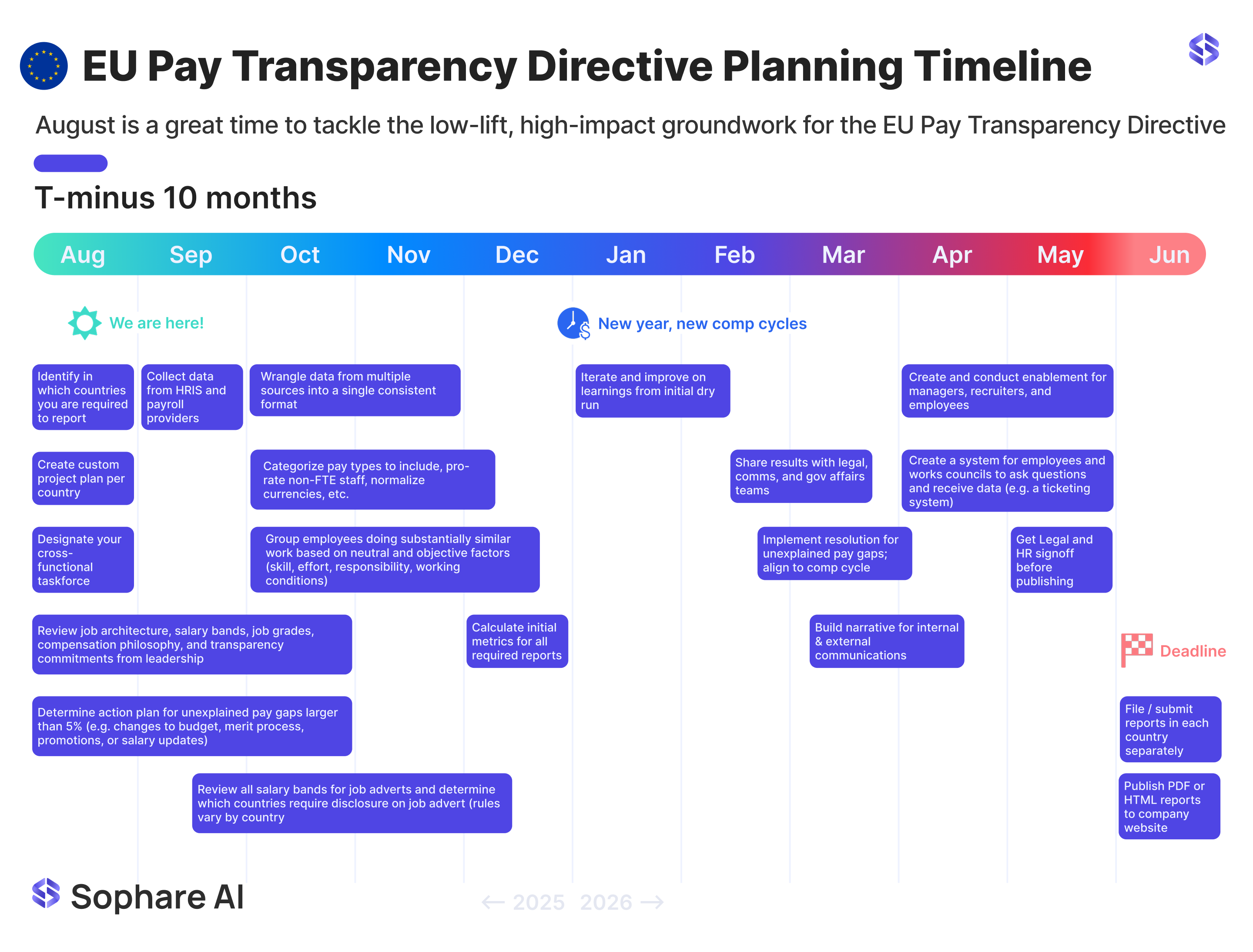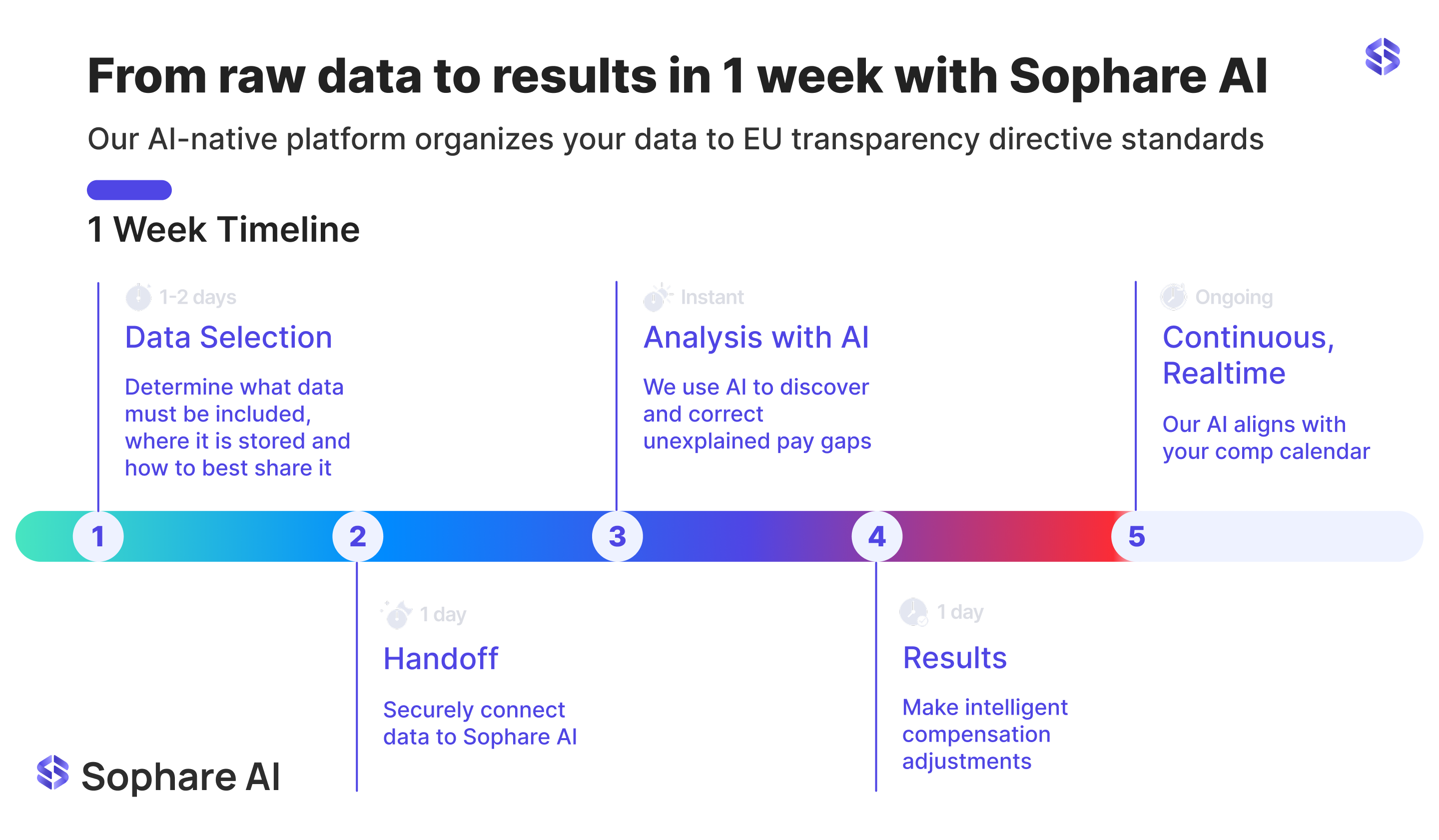10 Months to Go: Why August 2025 Is the Time to Begin Your EU Pay Transparency Directive Prep
7 August 2025 marks the 10-month countdown to the 🇪🇺 EU Pay Transparency Directive going live.
August also marks the peak of the holiday season across Europe, a time when many HR professionals are understandably more focused on vacations than upcoming EU Pay Transparency Directive compliance deadlines. With many teams running at a slower pace, now is a rare window to tackle the low-lift, high-impact groundwork for the EU Pay Transparency Directive. The directive goes live across member states on 7 June 2026, but smart, early action this summer can help prevent a last-minute scramble next spring. You don’t need to choose between taking time off and getting ahead. In fact, August is ideal for both. Don’t let August slip away into a moment in time–yes, like the Taylor Swift song!
August 2025 Action Plan for EU Pay Transparency Directive Compliance
Establish your taskforce: Identify the right people to own this work. Your core team should include stakeholders from compensation and rewards, employment legal, government affairs, public relations, and employee data. Don’t forget employee representatives. Collaboration from day one builds trust and alignment.
Create a project plan and roadmap of the journey: Start by working backwards from the directive’s enforcement date. Identify the official requirements and map them to your organization by entity and This gives you a clear picture of scope and complexity. From there, build a lean project plan that can adapt as regulations, guidance, and evolve.
Explore automation early: Start lining up demos with software partners who can work alongside your compensation team. The right partner can take on the heavy analytical lift, guide your taskforce with expertise, and give employees clear, compliant pay transparency information, whether you have a compensation team of one or one hundred.

Step 1: How to Establish Your Pay Transparency Taskforce
Start your pay transparency journey by assembling a cross-functional team with the right expertise. Your taskforce should include leaders from:
- Compensation and Total Rewards
- HR and People Operations
- Employee data experts such as analysts, data scientists, and engineers
- Payroll or finance specialists
- Employment legal advisors familiar with EU compliance requirements
- Public Relations for internal and external pay reporting communications
- Government Affairs for monitoring and engaging on regulatory developments
- Inclusion champions
Not every organization will have all of these teams in place, and that’s okay. The goal is to bring together a combination of skills and perspectives that cover these areas, even if individuals wear multiple hats. Smaller companies can still form an effective taskforce by drawing on the people who best understand compensation, compliance, employee data, and communications.
If your team doesn’t have in-house data engineers or data scientists who can calculate adjusted pay gaps and analyze cohorts of HR data, Sophare can take on this technical workload in the background. We handle the kind of statistical and engineering effort that would otherwise require multiple teams, allowing your taskforce to focus on decision-making and change management. We also use AI to modernize your compensation practices and eliminate rote spreadsheet work entirely.
Step 2: EU Pay Transparency Directive Project Plan & Roadmap
Develop a project plan that outlines all necessary workstreams and a clear timeline. Start by working backwards from the directive’s go-live date in June 2027, breaking larger initiatives into smaller, manageable workstreams. For each workstream, identify the taskforce member responsible and those who will be consulted.
Sophare centralises the work required ahead of deadlines, with proactive notifications and reminders to trigger data requests and keep progress on track.
Be aware that employee thresholds for reporting vary by country. Even if your organization is only required to report in one or two countries, the scope can still feel overwhelming. This is normal—the EU Pay Transparency Directive can involve more operational effort than GDPR, particularly when it comes to ongoing data analysis, reporting, and cross-team coordination.
Step 3: Using AI and Automation for Pay Transparency Compliance
Starting early and keeping momentum is essential. Sophare’s AI-native pay transparency analytics platform gives your taskforce the tools and expertise to get ahead of compliance deadlines and stay there. With Sophare, you can:
- Run your first pay audit in under a week: Conduct a “dry run” that pinpoints areas of risk and potential non-compliance before reporting season begins
- Gain a dedicated data science team: We act as your in-house data engineers, analysts, and statisticians, handling complex calculations and cohort analysis
- Continuously monitor pay equity: Real-time insights mean issues can be addressed immediately, avoiding costly backpay and reactive fixes
- Access the best AI-native insights dashboard in the market: Advanced visualizations and analytics, designed by engineers and data scientists from OpenAI, Carnegie Mellon, and Salesforce for accessibility across HR, legal, finance, and leadership
- Centralise everything: Deadlines, past reports, action items, and ongoing analytics all live in a single, secure environment
- Keep an eye on your competition: We track what your competitors are reporting and deliver actionable insights on a silver platter, powered by our best-in-class AI integrations
- Scale your reporting efficiently: As outlined in our previous article, we help you scale compliance processes efficiently as more countries and reporting cycles come online

By partnering with Sophare AI, you go beyond basic compliance. You position your organization as a proactive leader in pay transparency and equity.
In today’s market, getting compensation right is not just a regulatory requirement; it’s the most strategic move you can make to retain and attract top talent. Every major AI lab and tech giant is in an all-out war for the best people, and pay is at the center of that battle. Companies that can prove competitive, and transparent pay have the edge.
While our technology is powerful, our customers also value our boutique approach. We work as a true partner, tailoring solutions to your unique workforce and compliance needs. Many of our customers tell us this combination of enterprise-grade AI with a hands-on, collaborative relationship is what makes Sophare indispensable.
Looking ahead to September
Next month, we’ll dive deeper into compensation audits, job architecture, two more critical steps on your roadmap to transparency.
Frequently Asked Questions
When does the EU Pay Transparency Directive go into effect?
The directive goes into effect on 7 June 2026 across EU member states.
What is the difference between adjusted and unadjusted pay gaps?
An unadjusted pay gap compares average pay between groups without considering job differences. An adjusted pay gap controls for factors such as role, level, and location to measure pay differences for equal work.
How can companies prepare for the EU Pay Transparency Directive?
Start by creating a cross-functional taskforce, mapping requirements to your organization, and exploring automation tools like Sophare AI to manage compliance efficiently.

